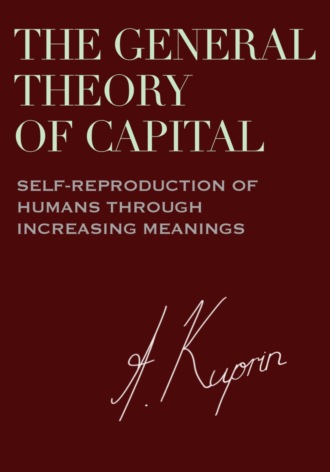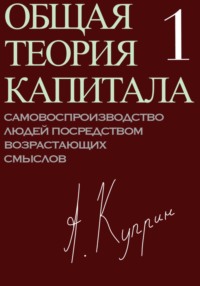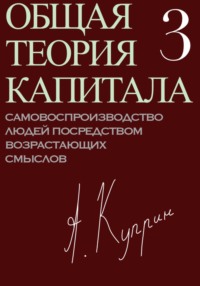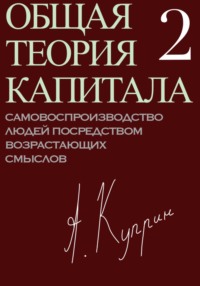
Полная версия
The General Theory of Capital: Self-Reproduction of Humans Through Increasing Meanings
“The distinction between simplicity and complexity raises considerable philosophical difficulties when applied to statements. But there seems to exist a fairly easy and adequate way to measure the degree of complexity of different kinds of abstract patterns. The minimum number of elements of which an instance of the pattern must consist in order to exhibit all the characteristic attributes of the class of patterns in question appears to provide an unambiguous criterion” (Hayek 1988-2022, vol. 15, p. 260).
The complexity of a given meaning is determined by the size of the minimal action necessary to reproduce that meaning. As a product of culture, man himself is also a meaning. In order to be able to transmit more and more cultural experiences, he must become more complex. With each generation, the minimal action required to reproduce man as a cultural being grows, and with it the complexity of learning.
The complexity of a minimal action converges to the entropy of its source, that is, the minimal subject. As we saw above, the complexity of a culture-society is determined by the number of alternative meanings (counterfacts) it can generate. At the same time, the complexity of a culture-society is defined by the size of the minimal action necessary for its reproduction. Thus, the entropy of the culture-society considered as a source of messages (counterfacts) is approximately equal to the average complexity of all possible messages from this source:
“Shannon’s entropy does not make sense for a particular string of bits. Entropy is a property of an information source. There are many possible messages, each with its own probability. Entropy measures the size of that universe of possibilities. In contrast, the algorithmic entropy makes sense for any particular string of bits. The strings themselves can have a higher or lower information content, according to whether they require longer or shorter descriptions. The two entropies are related to each other. For a source that produces binary sequences, the Shannon entropy is approximately the average of the algorithmic entropy, taking an average over all the possible sequences that the source might produce: H ≈ ave(K). Shannon entropy is a way to estimate the algorithmic entropy, on average” (Schumacher 2015, p. 231).
In other words, the complexity of meaning, when measured in cultural bits, converges on average to the entropy of the subject, be it culture-society as a whole or an individual taken as a source of (counter)facts. As Protagoras said, “man is the measure of all things: of the things which are, that they are, and of the things which are not, that they are not” (Plato 1997, p. 169). The minimal subject is a measure of the complexity of man, that is, of the unpredictability, uncertainty, randomness and surprise of his actions performed and not performed. The minimal subject is both the source and the product of the minimal action, and together they constitute the minimal meaning.
The historical increase in the complexity of a culture-society is reflected in the increase in both the number of (counter)facts it produces and the average size of the minimal action required to reproduce an individual meaning. The transition from cultural selection based on the alternation of human generations to traditional choice based on the alternation of generations of meanings raised both the entropy of the source of (counter)facts and the complexity of the (counter)facts themselves.
When we apply the achievements of information theory to culture, we must note the difference between the terms “information” and “meaning.” Information is determinateness in general or certainty, its measure is the reduction of uncertainty. The unit of information is a bit, “1” or “0.” In contrast to information, meaning is directed certainty, an act of change in a certain direction. Examples of directed certainty are the evolution of living beings and the evolution of meanings. Humans process information (certainty) into meaning (mediated, that is, directed certainty) by matching information with needs. The unit of meaning is the cultural bit—not just “1” or “0,” but also “+” or “–.” Meaning is information in human action that reproduces the patterns of the world.
“The orderly structures and patterns of which we are most immediately aware are those within our own minds, bodies, and behavior, but virtually all human beings have a strong conviction that corresponding to these patterns of mind and body are similar patterns in what might be called the ‘real world’” (Boulding 1985, p. 9).
At the same time, meaning is not limited to a mental act that operates with abstraction. Thinking in itself is not an interaction with meanings as with some “supramundane” entities. Meaning is a material action and the result of an action. When we compare meanings with each other, we can distinguish between their general and particular properties. A clock is a device for measuring time. But this general property of being a clock does not exist in itself. It exists in the context of human activities related to clocks. The abstraction of a clock only makes sense in action, for example when you read and think about what is written in this book.
Is the watchmaker blind, is culture left to chance?
In his book The Blind Watchmaker: Why the Evidence of Evolution Reveals a Universe without Design (1986), Richard Dawkins cited 18th-century theologian William Paley’s argument that if we find an object as precise and complex as a clock on a heath, we can assume that it did not come into being spontaneously, but was designed. Paley applied this argument to nature to prove the existence of God. Dawkins believed that Darwin’s theory of natural selection provided an answer to Paley’s argument:
“Natural selection, the blind, unconscious, automatic process which Darwin discovered, and which we now know is the explanation for the existence and apparently purposeful form of all life, has no purpose in mind. It has no mind and no mind’s eye. It does not plan for the future. It has no vision, no foresight, no sight at all. If it can be said to play the role of watchmaker in nature, it is the blind watchmaker” (Dawkins 1996, p. 5).
Dawkins argued that natural selection could have created the animal world even without the will of God, and Donald Campbell argued that cultural selection could have created knowledge and civilization even without the will of man. In his works of the 1950s and 60s, Campbell put forward the theory of “blind variation and selective retention,” according to which man creates cultural variations randomly, without foreseeing the future course of events, and these variations are then subjected to selection in which only those variations that have proven useful are stored and passed on through learning. Learning is “the retention of adaptive response patterns for subsequent utilization, thus abbreviating the trial and error process” (Campbell 1959, p. 158). Taking Dawkins and Campbell’s argument further, we can conclude that man is not a subject of culture at all, that culture does not need human design, that meanings develop on their own: they arise randomly and are passed on through involuntary learning. However, some people feel uneasy with this assumption:
“…Historical analyses of scientific and technological change suggest that cultural change is not quite so directed, and foresight not quite as accurate, as commonly assumed. Historical figures often claim retrospectively to have guided cultural change in particular directions, yet such claims may have the benefit of hindsight and be self-servingly exaggerated. However, there is a general lack of systematic evidence regarding this issue, at least compared to the careful experiments conducted by Luria and Delbrück in biology. We should therefore be prepared to accept that cultural evolution may, at least in some instances, be directed rather than blind and that there is a valid difference here between cultural and biological evolution” (Mesoudi 2011, p. 46). [Luria and Delbrück’s experiments in the 1940s showed that mutations in bacteria are not the result of selection pressure, but occur by chance.—A.K.]
So, is any new meaning a matter of chance? Henry Quastler once posed this question as follows: “How does one know that at least some new information has emerged or that the new work is more than a rearrangement, according to existing laws, of previously existing patterns?” (Quastler 1964, p. 17).
We showed above that a meaning s can be reduced to a minimal action s*. A minimal action is the shortest description of a meaning that allows its reproduction. Obviously, a new meaning emerges if it cannot be reduced to another meaning. It is known from information theory that the closer the length of string s is to the length of the minimal action s*, the more random the meaning is: “Among all the descriptions of s, there is a shortest one called s*, and the length of s* is the algorithmic entropy K(s). This led to a neat definition of randomness: A string s is random if it has no description much shorter than itself. Its entropy is about equal to its own length: K(s) = L(s*) ≈ L(s)” (Schumacher 2015, p. 240).
Any truly new information is therefore random and unpredictable. However, new information is not yet new meaning. Through their actions, people strive not only to create new information, but also to satisfy their needs. Meaning is not only determinateness or certainty, but also direction. New information must be inscribed in the existing culture in order to make sense. Any new meaning is both random and necessary. Quastler sees this as the answer to his question:
“The answer may be in the composer Pierre Boulez’s definition of artistic creation: ‘To make the unpredictable inevitable.’ To restate this beautifully succinct saying: if there is a truly new element in a work, then it should have been quite impossible to predict this element beforehand, on any basis; if the work is to be successful, then this unpredictable element must acquire the unavoidability of a law” (Quastler 1964, p. 17).
Meanings arise by chance and are transmitted by necessity. All meanings are accidental, but once established they become the norm. Quastler calls this “random and remembered choice.” “The ‘accidental choice remembered’ is a mechanism of creating information and very different in nature from mechanisms of discovering information” (Quastler 1964, p. 16).
If meanings evolve on their own, and not through human agency, then is not all culture the result of the evolution of meanings, their random changes, and selective retention? The stage of mixed natural and cultural selection lasted for hundreds of thousands, perhaps millions of years; the stage of traditional choice lasted for thousands or tens of thousands of years. During this period, proto-human and early human populations self-reproduced by collective rather than individual action. Collective existence overshadowed the lives of individuals, their plans, and their destinies. Alfred Kroeber wrote that looking back over thousands of years of history, one might come to believe that hidden forces control individuals who have no influence over their lives:
“When one has acquired the habit of viewing the millennial sweeps and grand contours, and individuals have shrunk to insignificance, it is very easy to deny them consequential influence, even any influence—and therewith one stands in the gateway of belief in undefined immanent forces; a step more, and the forces have become mysterious” (Kroeber 1952, p. 9).
The difficult questions arise as to whether the individual is the origin of all action, whether he plays a significant role in the evolution of culture and whether man has free will at all.
Hard problem of subject
As with natural selection, in the early stages of mixed selection, individuals were not its agents but merely inactive elements of self-reproducing populations—imitators and followers of first animal and then human traditions. A single human cannot reproduce himself. A human alone cannot give birth to or raise another human. He cannot even retain his common sense when alone. But as meanings accumulated in the course of mixed selection, the experience and sophistication of primitive communities increased, and with it the agency of individuals.
The increasing complexity of technologies, organizations and psychologies implies the emergence of consciousness and personality as its manifestation. Man becomes (self-)conscious and is a personality when he detaches himself from the community and at the same time searches for himself in a community of which he is a part. Michael Graziano writes that consciousness is a model of attention: we attribute attention to other people and therefore attribute it to ourselves (Graziano 2013). We would rather say that consciousness is a model of meaning: we attribute it to others and therefore attribute it to ourselves. Consciousness is a function that results from mental activity, that is, thinking:
“It is the ability to extract from mental activity its algorithms (methods), to evaluate the adequacy or inadequacy, the quality of one’s actions, to program, regulate and control them. A person extracts the criteria of consciousness from the environment, from its phenomena and moral and ethical standards accepted in the family, the environment and society as a whole” (Wiesel 2021, p. 136).
Consciousness was not given to humans from the beginning. Julian Jaynes wrote in his book The Origin of Consciousness in the Breakdown of the Bicameral Mind (1976) that humans originally had no consciousness and that it only emerged in historical times, perhaps in the age of writing. (Self-)consciousness arose when the “voices” that told a person what to do became the voice of his own mind. He finds confirmation of this in the poems of Homer and other ancient authors:
“In distinction to our own subjective conscious minds, we can call the mentality of the Myceneans a bicameral mind. Volition, planning, initiative is organized with no consciousness whatever and then ‘told’ to the individual in his familiar language, sometimes with the visual aura of a familiar friend or authority figure or ‘god,’ or sometimes as a voice alone. The individual obeyed these hallucinated voices because he could not ‘see’ what to do by himself” (Jaynes 1976, p. 75). “Once established, once a man can ‘know himself,’ as Solon advised, can place ‘times’ together in the side-by-sideness of mind-space, can ‘see’ into himself and his world with the ‘eye’ of his noos [mind], the divine voices are unnecessary, at least to everyday life. They have been pushed aside into special places called temples or special persons called oracles. And that the new unitary nous (as it came to be spelled), absorbing the functions of the other hypostases, was successful is attested by all the literature that followed, as well as the reorganization of behavior and society” (ibid., pp. 287-288).
Robert Sapolsky suggests that free will is determined by a person’s ability to resist biological impulses (Sapolsky 2017, p. 597). But where does this ability come from? It comes from the dual nature of humans—as animals and as social beings. In the Phaedrus, Plato compared the soul to the union of a pair of winged horses and their charioteer (Plato 1997, p. 524). In the Republic, he wrote that man is the unity of three principles: rational, affective (rage and desire for competition) and natural (passion and lust). “Do we learn with one part, get angry with another, and with some third part desire the pleasures of food, drink, sex, and the others that are closely akin to them? Or, when we set out after something, do we act with the whole of our soul, in each case?” (Plato 1997, p. 1067).
Socio-cultural experience is an accumulation of accidental and remembered choices transmitted through learning. An individual is able to choose at all because he has an essential part of this experience. Man as a cultural microcosm is a copy of society as a macrocosm. “…The essence of man is no abstraction inherent in each single individual. In its reality it is the ensemble of the social relations” (Marx and Engels 1975-2004, vol. 5, p. 4). “Society” and “individual” are only two opposite points of the same “man” when considered as an abstraction. “Individuals may carry out actions traditionally indexed as ‘thought’ or ‘feeling’; however, these actions may properly be viewed as forms of relationship carried out on the site of the individual” (Gergen 2001, p. 119).
An individual accumulates individual experiences that enable him to make a choice between (counter)facts—provided they lie within the limits of his individual experience. A striking example is professional experience: the greater this is, the higher the person’s ability to make decisions in uncertain situations related to his occupation. In traditional agrarian societies, not only the society as a whole, but also an individual is capable of making decisions, that is, he has free will.
People develop through learning, through the accumulation of meanings that are passed on from generation to generation in the form of cultural experiences: norms, knowledge and skills. Increasing meanings are revealed in the complication of causal models, which reflect the relationships between goals and results of actions and are an accumulated prerequisite for new actions. A person becomes a subject when his experience allows him to reason and choose. In the beginning, the causal model (i.e. knowledge) is a means of activity, and at the end it becomes the subject himself (i.e. consciousness).
Free will is based on the multiplicity of meanings, on the human ability to invent counterfacts. Freedom is found at the intersections of necessities. In other words, the transition from selection to choice did not occur when (proto-)humans acquired the ability to choose, but when they learned what to choose from. Choice arose simultaneously with the ability to create counterfacts. Where, then, did the counterfacts come from? It is reasonable to assume that choice arose when contacts between communities began, so that members of the communities got to know each other and could compare and exchange meanings. Thus, the accumulation of cultural experience provided humans with the opportunity to choose actions.
Free will is the human ability to create random options at the intersection of necessities—natural and socio-cultural programs—and to choose from the options. Without accurate data on the spans of the bridge connecting primates and humans, we cannot say at what exact moment the “voices” in a person’s head became the voice of his own mind. But we can say with some confidence that the human mind is the result of the interaction of three forces: primary emotions, meanings, and random but remembered choices. The mind is not a program, but an evolutionary process, it is not reducible to instincts and learning. “…Culture is not equatable directly to the environment or econiche. … The human brain is a selectional system, not an instructional one” (Edelman 2006, p. 55). The changes in animals depend mainly on changes in environmental conditions and genes. The changes in humans depend not only on the environment, but also on the human mind and the (counter)facts it creates. Freedom consists, for example, in the ability to choose between meanings that are detrimental to one’s own chances of survival and the chances of survival of one’s species. “The habit of celibacy is presumably not inherited genetically” (Dawkins 1976, p. 213).
Mutual evolutionary selection of subjects and meanings occurs when people choose between strategies. Choosing here means not only making a decision but also implementing it. Competition of meanings occurs in choosing between them, and competition of people occurs in action, i.e. in implementing chosen strategies. In the marshmallow experiment, children were given the choice of eating one candy immediately—or two, but only after waiting 15 minutes. The child chose a strategy—eat one candy or wait for two—and the strategy chose the child. A survey conducted 20 to 30 years later found that those who could wait until the second candy as children were more successful as adults.
However, as we saw above, the fate of the Franklin expedition shows the limitations of the minds of people of the industrial age compared to the cultural experience of hunter-gatherers, accumulated by many generations of people and meanings. Rational strategies of individuals lose out to simple learning algorithms. Algorithms of socio-cultural self-reproduction do not imply individual decision-making, but a whole evolutionary process of division, addition, multiplication, complication and increase of meanings. The increase of meanings, including activity, its norms and active power itself, is aimed at overcoming uncertainty.
3. Division, addition and multiplication of meanings
Activity and efficiency
The same action can bring different results depending on the circumstances in which it is performed and the natural and cultural phenomena on which it relies. If the same seed is thrown on a rock or on fertile soil, it can yield two different effects. But the complexity of the result will be the same in both cases. The effect can be the result of chance (as in Robinson Crusoe who threw the seed in a good place) or of necessity revealed by knowledge, that is, in a causal model:
“The archetype of causality research was: where and how must I interfere in order to divert the course of events from the way it would go in the absence of my interference in a direction which better suits my wishes? In this sense man raises the question: who or what is at the bottom of things? He searches for the regularity and the ‘law,’ because he wants to interfere” (Mises 1996, p. 22).
Knowledge reveals the causes of phenomena and enables people to master them and turn them into effects. Every technology is based on the transformation of natural and cultural phenomena into effects:
“… The base concept of a technology—what makes a technology work at all—is always the use of some core effect or effects. In its essence, a technology consists of certain phenomena programmed for some purpose. I use the word ‘programmed’ here deliberately to signify that the phenomena that make a technology work are organized in a planned way; they are orchestrated for use. This gives us another way to state the essence of technology. A technology is a programming of phenomena to our purposes” (Arthur 2011, p. 51).
The programming of phenomena is done by constructing causal models—event patterns and action programs. In an event pattern, the cause is related to the phenomenon; in an action program, the action is related to the effect.
Material technologies are based on material phenomena. For example, the efficiency of a watermill depends on how it uses the fall of water under gravity. The undershot wheel can be placed directly in the water flow, simplifying the design of the mill but increasing the likelihood of breakdowns. The overshot wheel requires the construction of a dam and canal to bring water to the top of the wheel. Historically, undershot wheels preceded overshot wheels and were long considered more efficient until John Smeaton showed in 1759 that the efficiency of overshot wheels was 52 to 76 percent, compared to 32 percent for the best undershot wheels (Smil 2017, p. 152).
Social technologies are based on social phenomena—for example, we will show that money is based on the phenomena of use and exchange value.
Abstract technologies are based on abstract phenomena. The Antikythera mechanism, with its gears and algorithms, is based on the phenomena of celestial mechanics. This mechanism, developed in the 2nd century BC and recovered from a sunken ship in 1900, made it possible to calculate the dates of 42 astronomical events, including the dates of future solar and lunar eclipses.
The same level of complexity may be characterized by different levels of efficiency: there can be more and less effective workers with the same skills and tools. Increasing efficiency does not require greater complexity. But increasing complexity requires greater efficiency. Based on the principle of least action, people increase the complexity of their activities only when it is necessary to increase efficiency. The complexity of meanings increases to the extent necessary to increase their effectiveness, that is, to more extensively master phenomena.




